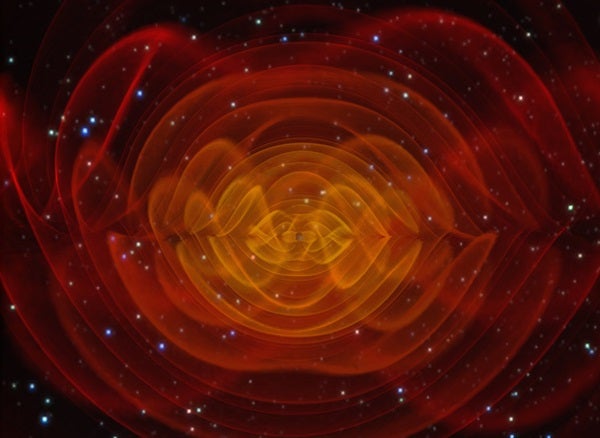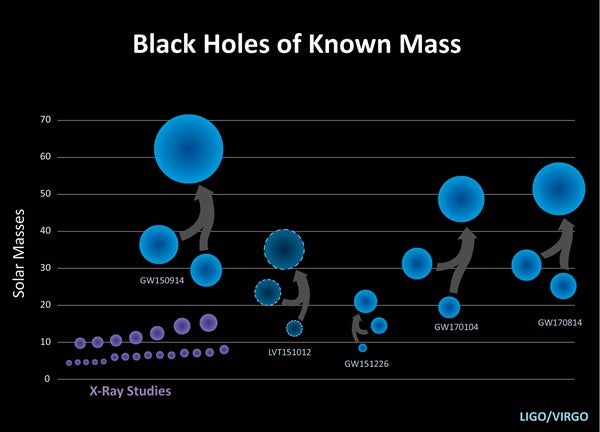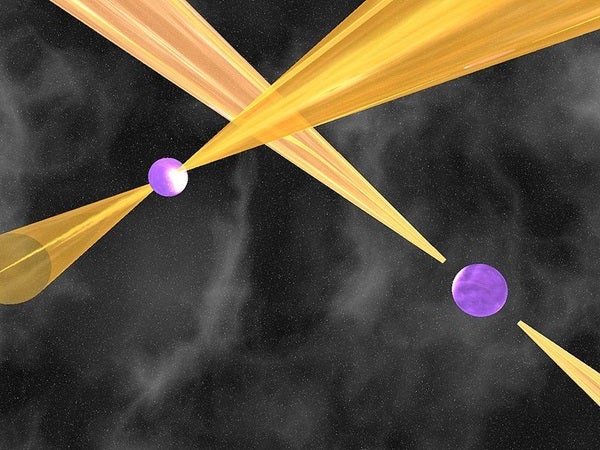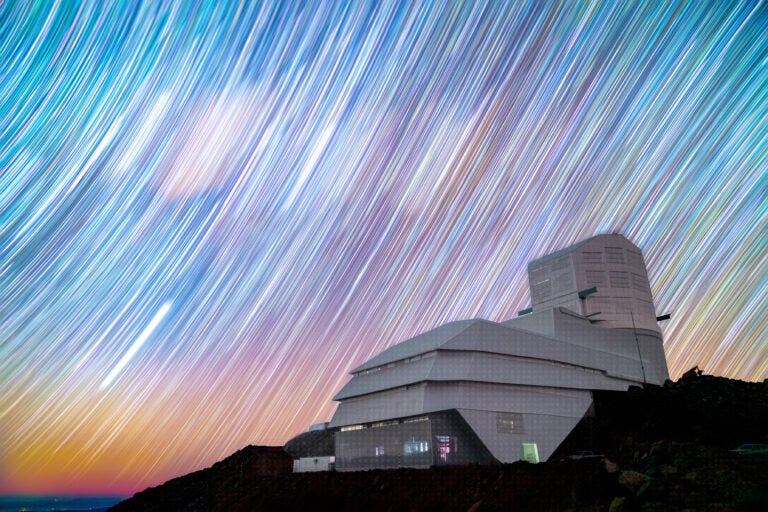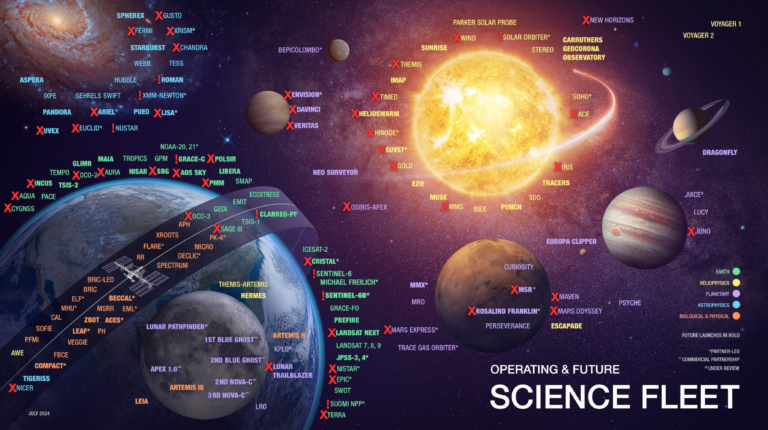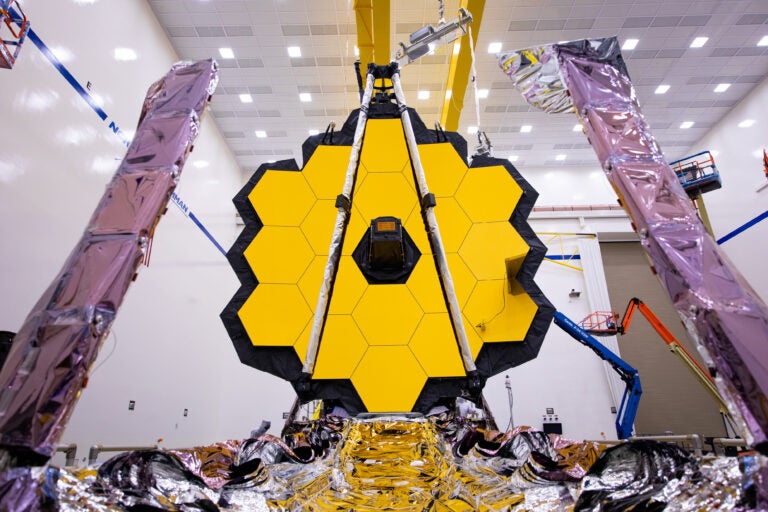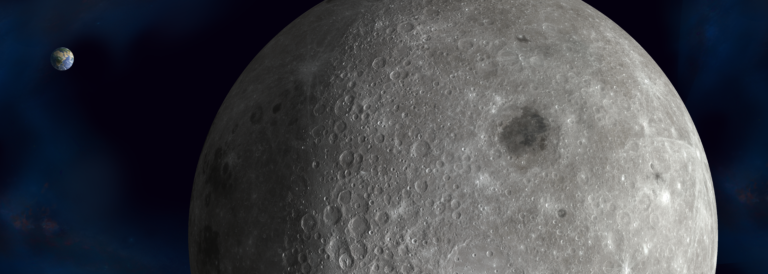Today, we’re witnessing the genesis of a whole new type of astronomy, and this one doesn’t use light at all. It uses gravitational waves.
The basics
According to the theory of relativity, gravity acts like currents on the ocean of space-time, gently tugging on planets and stars. Gravitational waves are like the ripples on this cosmic ocean, produced by binary neutron stars orbiting each other, some supernova explosions, and the death-spirals of black holes before they collide.
In fact, it’s very easy to make gravitational waves. Stand up and turn around once, and you’ve made a (pathetically weak) gravitational wave. But some things make exceptionally powerful waves, such as the three collisions between black holes detected by the Laser Interferometer Gravitational-wave Observatory (LIGO), as well as a fourth detection made jointly by LIGO and its European counterpart Virgo. (One of those LIGO-only detections is “marginal,” meaning the signal isn’t good enough to be absolutely sure it’s a black hole collision, but it’s here for completeness.)
In fact, the LIGO/Virgo detections have already shown us something new. All of the 22 stellar-mass black holes previously discovered using X-ray telescopes are lighter than 20 times the mass of the Sun.
By contrast, most of the LIGO/Virgo black holes are more than 20 times the Sun’s mass, and after the mergers, they became even more massive. The first gravitational wave signal we received came from two black holes merging to form a monster over 60 times the mass of the Sun.
It’s not just that the black holes found using gravitational waves are bigger, but they also seem to collide more often than astronomers thought. That means we have to figure out how these pairs of black holes form in the first place, since most models fail to predict the number of massive collisions we’ve already seen.
This is why the new field of gravitational wave astronomy is so exciting. Every new method we develop to study the universe results in the discovery of something unexpected. Supermassive black holes, pulsars, gamma-ray bursts, and many more objects were discovered with the invention of new branches of light-based astronomy. So, gravitational-wave astronomy is likely to turn up others we can’t predict today.
Meanwhile, the field is just getting started. LIGO isn’t operating at its maximum capabilities yet, and this year is the first time its two detectors have worked in tandem with Virgo. When all the observatory’s upgrades are done, we’ll detect gravitational waves from farther distances, and catch fainter signals closer to home.
Those weaker sources will probably be the next big find, and they will likely be colliding pulsars — the remains of super-dense cores of massive stars. When these objects collide, they produce a gamma-ray burst and a lot of visible light, but they also generate gravitational waves. Seeing the action via both light and gravitational radiation will give us extra information we can’t get other ways.
On the rarer side, some supernova explosions are likely to produce detectable gravitational waves. And since we don’t know exactly how stars explode, LIGO and Virgo may be able to provide us with some valuable insight. Supernovae make a lot of light (like colliding pulsars), so we could again use multiple types of observations to study the same event.
A cosmic workaround
LIGO, Virgo, and the upcoming Japanese observatory KAGRA are massive as far as scientific instruments go. Each of LIGO’s L-shaped detectors has arms 2.5 miles (4 kilometers) long, while Virgo’s arms are nearly 2 miles (3 km) long. The arms must be long to ensure they’re sensitive to gravitational waves, which can have large wavelengths. LIGO, for example, is currently most sensitive to wavelengths between about 60 and 600 miles (100-1,000 km). Even so, many astronomical objects produce gravitational waves too big for the detectors to catch. This is because gravitational waves are often comparable to the physical size of their source.
For example, a pair of supermassive black holes orbiting each other could produce waves as big as the Solar System, which we cannot detect. However, the universe provides ways to observe those gravitational waves in the form of pulsars, which flash as precisely as some of our most accurate clocks. When gravitational waves pass through the space occupied by these pulsars, they stretch and squeeze this space, affecting the wavelength and timing of the pulsars’ signals when they eventually reach Earth. Astronomers can precisely measure these timing differences using radio telescopes, such as Arecibo in Puerto Rico.
Now, astronomers are making observations of pulsars spread throughout the sky — a “pulsar timing array” — to try to spot timing differences caused by gravitational waves. So far, these observations haven’t turned up any signals. But, because it requires many years to get enough data, it’s likely only a matter of time before we spot the fingerprints of gravitational waves on the pulses we receive. Meanwhile, gravitational-wave astronomers are constantly designing new instruments and thinking of novel ways to observe the invisible.

